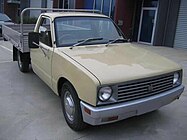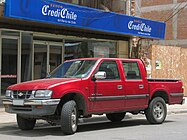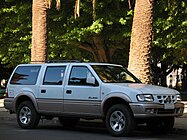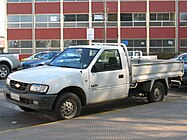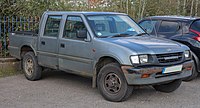Изузу быстрее
| Изузу быстрее | |
|---|---|
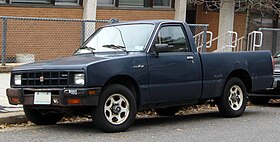 Второе поколение Isuzu p'up (США) | |
| Обзор | |
| Производитель | Исузу |
| Также называется | Chevrolet luv |
| Производство | 1972–2002 |
| Тело и шасси | |
| Сорт | пикап |
| Макет | Передний двигатель, задний привод Передний двигатель, четырехколесный привод |
| Хронология | |
| Предшественник | Исузу оса Холден WB (для Австралии, с 1984 года) |
| Преемник | Isuzu D-Max Isuzu Man (Северная Америка) |
Isuzu быстрее - это пикап , который был изготовлен и продан Isuzu в период с 1972 по 2002 год в течение трех поколений. Он был продан под бесчисленными различными табличками, чаще всего они продавались в соответствии с соответствующими кодами моделей: Isuzu KB для первого и второго поколения, TF для третьего. В Японии «более быстрое» название в конечном итоге было вытеснено Родео . Он также продавался по ряду других брендов из портфеля General Motors. Более быстрее преуспели во всем мире Isuzu D-Max , за исключением Японии и Северной Америки .
Первое поколение (1972–1980)
[ редактировать ]| Первое поколение | |
|---|---|
 Chevrolet Luv 2-дверный пикап (США) | |
| Обзор | |
| Также называется | Изузу быстрее (Таиланд) Isuzu KB Бедфорд ок Chevrolet luv |
| Производство | 1972–1980 |
| Сборка | Япония: завод Фудзисава , Фудзисава, Канагава Таиланд: Самронг, Самут Пракан Индонезия: Бекаси , Западная Ява Филиппины: Дасмарьяс (Pilipinas GM) |
| Тело и шасси | |
| Стиль тела | 2-дверное шасси кабины 2-дверный пикап 4-дверный пикап |
| Связанный | Исузу Флориан |
| Трансмиссия | |
| Двигатель | |
| Передача инфекции |
|
| Размеры | |
| Колесная база |
|
| Длина |
|
| Ширина |
|
| Сгибать вес | 1 099–1,290 кг (2423–2 844 фунта) |
| Хронология | |
| Преемник | Chevrolet S-10 |
Isuzu из Японии представила серию KB20 / 25 более быстрый пикап в 1972 году. Регулярные модели колесной базы были обозначены «20», в то время как «25» ссылались на более длинную версию. Полученный из Исудзу Флориана , тем более быстрее обменивались много компонентов, включая двери и фронтальную сборку. Он послужил заменой для Wasp Isuzu , версии Bellett , которая предшествовала Флориану. Были произведены как отдельные, так и двойные дизайны фронта.
Из -за внешних измерений, и предлагаемые двигатели были признаны в соответствии с японскими правилами , платформа была классифицирована в благоприятном «компактном» обозначении и конкурировала с другими японскими продуктами, продаваемыми в Японии в то время.
На большинстве экспортных рынков Isuzu переименовался в то, что «Isuzu KB». [ 1 ] Тем не менее, быстрее часто распределяли по розничным каналам General Motors (GM) и продавались под брендом Chevrolet как « Chevrolet luv » - Luv - аббревиатура для легкого автомобиля . [ 2 ] Бедфорд , европейская дочерняя компания GM, также предложила автомобиль под названием «Бедфорд KB». [ 3 ]
Isuzu быстрее использовал традиционное шасси пикапов с лестничной рамой и листовой пружины задней подвеской с живой осью . Спереди, подвеска A-Arm использовала независимую конфигурацию . Колесная база 2600 мм (102,4 дюйма) была аналогична ее конкурентам, как и грузовой залив 1855 мм (73,0 дюйма). В отличие от предыдущей осы , была также длинная версия колесной базы ( KB25 ), которая имела 2995 мм (117,9 дюйма) между осями, что составило 2290 мм (90,2 дюйма). [ 4 ]
В 1978 году с полным приводом стала доступна версия с кодом шасси KB40 , но продана под этикеткой «быстрее родео» в Японии. Была также двойная версия кабины (на более длинном шасси). Продажи закончились в 1980 году, когда было введено второе поколение. Двигатель, используемый на большинстве рынков, представлял собой 1,6-литровый (1584 куб . См ) . (46 кВт). Максимальные скорости составляли 145 км/ч (90 миль в час) и 115 км/ч (71 миль в час) для бензиновых и дизельных версий соответственно. [ 4 ] В Японии первоначально был установлен двигатель верхнего клапана (G161); Это производит 84 пс (62 кВт) для максимальной скорости 135 км/ч (84 миль в час). [ 5 ]
- Австралия
General Motors-Holden импортировал более быстрое в Австралию с ноября 1972 года под названием « Chevrolet Luv », переименуя его «Isuzu KB» в 1977 году, прежде чем он был заменен в декабре 1980 года моделью второго поколения (Badged « Holden Rodeo »). [ 6 ] [ 7 ] [ 8 ] Холден запустил LUV в Австралии с 1,6-литровым бензиновым двигателем в 1,6-литровый бензиновый двигатель, который обеспечил мощность приблизительно 50 кВт (67 л.с.) и 110 Нм (81 фунт-фунт) крутящего момента. [ 8 ] Получив раннюю репутацию надежности и долговечности, эти оригинальные модели заднего привода имели четырехступенчатую механическую коробку передач, строительство короткоприкосновения и около 1000 кг (2200 фунтов) полезной нагрузки. [ 8 ]
Обновление в 1978 году расширило диапазон LUV-теперь включающая модель KB20 с короткой колесной базой , новую длинную базу KB25 и четырехколесную KB40 . коротку [ 8 ] Эти варианты KB25 и KB40 были предложены как в шасси кабине, так и в утилит (пикап), и могут быть указаны с помощью 1,6-литрового бензинового двигателя или недавно доступного 1,95-литрового дизеля. [ 8 ] Дизель произвел 45 кВт (60 л.с.) и 113 Нм (83 фунта -фута). [ 8 ]
- Северная Америка
Ответственность за продажи в Северной Америке была делегирована General Motors. Таким образом, Isuzu был продан через дилерские центры Chevrolet в качестве «Chevrolet luv». куб литровый ( 1817 Единственным двигателем был 1,8 - .
Продажи в Соединенных Штатах марте 1972 года в ответ на пикапы Datsun и Toyota , а также Ford Mazda курьер начались в . [ 2 ] Чтобы обойти 25 -процентный тариф на легкие грузовики (известные как налог на курицу ), LUV были импортированы в конфигурацию шасси кабины , которая включала весь легкий грузовик, меньше грузовой коробки или грузовика и имела только 4 -процентный тариф. [ 9 ] Впоследствии кровать для грузовика будет прикреплена к шасси, а автомобиль можно было продавать в виде легкого грузовика.
The LUV's exterior was updated slightly for the 1974 model year, but the first major update came in the 1976 model year, when a three-speed automatic transmission option and front disc brakes were added. Power was up to 80 hp (60 kW) for 1977, and sales continued to rise. An exterior refresh and the addition of a 2,285 mm (90 in) cargo bay option, with longer 2,995 mm (118 in) wheelbase, brought sales up to 71,145 in 1978. The addition of four-wheel drive for 1979 brought the LUV to the attention of Motor Trend magazine, and earned it their second "Truck of the Year" award. The LUV was the first four-wheel-drive minitruck available and set a new trend.[10] Sales peaked at 100,192.
Second generation (1980–1988)
[edit]| Second generation | |
|---|---|
 1981–1982 Chevrolet LUV 2-door pickup (US) | |
| Overview | |
| Also called |
|
| Production | 1980–1988 1980–1994 (Indonesia and Latin America) |
| Assembly | Japan: Fujisawa Plant, Fujisawa, Kanagawa Colombia: Bogotá Chile: Arica New Zealand: Trentham Thailand: Samrong, Samut Prakan Philippines: Dasmariñas (Pilipinas GM) Indonesia: Bekasi, West Java (until 1994) Surabaya, East Java (Holden Lincah/Raider) |
| Body and chassis | |
| Body style | 2-door cab chassis 2-door pickup truck 2-door pickup truck (Space Cab) 3/5-door SUV 4-door pickup truck (Crew Cab) |
| Powertrain | |
| Engine | |
| Dimensions | |
| Wheelbase |
|
| Length |
|
| Width |
|
| Curb weight | 1,099–1,450 kg (2,423–3,197 lb) |
| Chronology | |
| Predecessor | Holden WB (Australia, since 1984) |
The second generation was more commonly marketed worldwide under the Isuzu label (either as the "Isuzu KB" or just plain "Pick Up"). It continued to use the "Rodeo" suffix for the four-wheel drives. The second generation model was the first Isuzu pickup offered in three cab styles: single cab, double cab and "Space Cab" ("Sports Cab" in some markets). Although it had received a completely new body, its chassis remained the same as its predecessor. Sales in the UK continued as the Bedford KB.
This generation was not shared with the GM North American GMT325 platform, which replaced the North American Chevrolet LUV in 1982.
Australasia
[edit]Holden in Australasia distributed the second generation Isuzu Faster between January 1981 and August 1988 as the first generation or KB series "Holden Rodeo", for which production started in December 1980.[6][13] Early KBs were fitted with circular headlamps and a horizontal four-bar grille, but a 1983 model year facelift in December 1982 brought rectangular lamps with a 12-port grille insert as well as restyled side mirrors.[13][14]
At launch, Holden made the Rodeo available in utility (pickup) and cab chassis body variants in both rear- (LWB) and four-wheel drive (SWB) layouts. All models featured a floor- or column-mounted four-speed synchromesh manual transmission coupled with the 1.6-liter gasoline or 2.0-liter diesel engines.[15] The 1983 model year update increased these displacements to 1.8- and 2.2-liters, respectively. At the same time a new upmarket "LS" model was issued (coded KB28), fitted with a 2.0-liter gasoline engine and five-speed manual.[16] For the 1984 year model, beginning in February 1984, the 2.0-liter became the base gasoline engine.[17]
With the demise of the Holden WB in 1984, the Rodeo became the only pickup and chassis cab vehicle available from Holden (until the arrival of the car-based Holden VG Utility in 1990). The 1985 model from July the same year[13] signaled another facelift, the release of the two-door Space Cab body style, the debut of a new 2.3-liter gasoline engine, and the deletion of the four-speed manual and column-shift selector (making the floor-mounted five-speed manual standard).[18] From March 1986 (1986 model year), the 2.3-liter became the standard gasoline engine and in April the subsequent year, the 1987 models obtained a final facelift with an open rectangular grille design and optional power steering.[13][19][20]
Versions with unique local specifications were assembled in New Zealand at GM's Trentham assembly plant. These were also badged as Holdens.
Europe
[edit]The second generation KB was introduced in many European markets, not only Britain, as the Bedford KB. In subsequent years continental markets saw a switch to Isuzu badging as General Motors stopped using the Vauxhall and Bedford brands outside of the United Kingdom.[21] It was called by the model code, Specifications and trims varied depending on market needs, but most received the 1.6-liter G161Z petrol engine with a twin carburettor and 80 PS (59 kW), or the 2-liter C190 diesel inline-four with 54.5 PS (40 kW). Two-wheel-drives were also available on a long wheelbase not offered in combination with four-wheel-drive.[22]
North America
[edit]The United States continued to receive the Faster under the "Chevrolet LUV" name for the second generation, introduced in 1980 for the 1981 model year. The gasoline engine remained the same, but the LUV was now available with an Isuzu C223 diesel engine making 58 hp (43 kW) at 4300 rpm and 93 lb⋅ft (126 N⋅m) at 2200 rpm. This new engine gave the rear-wheel drive diesel LUV a fuel economy rating of 33 mpg‑US (7.1 L/100 km) city / 44 mpg‑US (5.3 L/100 km) highway.
After the 1982 model year, General Motors stopped selling the Chevrolet LUV (although many '82s lingered on forecourts into the next year) in the United States in favor of their own S-10 compact pickup. Meanwhile, Isuzu had sold their version in parallel with the LUV since their 1981 entry to the US market, under the name "Isuzu P'up" (short for "pickup"). Isuzu's version received another grille and other differences to set it apart from the LUV, not the least of which is the giant "ISUZU" block letters on the tailgate.[10] The P'up received the same engines as the LUV; either an 80 hp (60 kW) 1.8-liter gasoline inline-four (G180Z) or a 2.2-liter diesel version with 58 hp (43 kW) (C223). Four-wheel drive was available with either engine but only in short-wheelbase form,[23] though some 4WD long-wheelbase diesel are known to exist, possibly dealer-installed or aftermarket conversions. Because of technology-sharing agreement between GM and Isuzu, the diesel was also offered with the LUV's replacement until 1985. Later, the gasoline engine was upgraded to Isuzu's 1.95-liter four and a turbodiesel version was added, with the turbo standard on diesel-engined 4WD models.[24]
For 1987, the P'up gained a "Spacecab" extended cab model.[24] This was only available in LS or Deluxe trim. Also new was the option of a 2.3-liter gasoline four (standard on 4WDs).[24] Production for the Mexican and Latin American markets did not end until 1994.
South America
[edit]As with North America, the Isuzu KB was generally issued under the name "Chevrolet LUV" in South America. Manufactured in Colombia from Japanese complete knock down (CKD) sets, these models entered production in 1980 to be exported to other South American countries, continuing on until the release of the TF series in 1988. At the start, the versions assembled were the K-26 and K-28. It was offered with a 1584 cc (G161Z) engine.[25] It was also offered a (C190) diesel version of 1951 cc and 62 PS (46 kW).[26] This model of the Isuzu KB only was assembled in Chile via CKD kits from Japanese origin.[26]
-
Isuzu KB 2-door pickup (Chile)
-
1981 Holden Rodeo (KBD26) 2-door cab chassis
-
1985 Holden Rodeo (KB) 2-door pickup (New Zealand)
-
1982–1985 Holden Rodeo (KB28) LS 2-door pickup
-
1988 Chevrolet LUV DLX Crew Cab
Third generation (TF; 1988–2002)
[edit]| Third generation | |
|---|---|
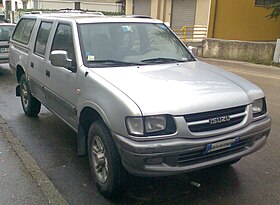 Isuzu TF 4-door pickup (Italy) | |
| Overview | |
| Also called | Isuzu Rodeo (Japan and Thailand; 4WD only) Isuzu Dragon Eyes (Thailand; 1996–2002) Isuzu Dragon Power (Thailand; 2000–2002) Isuzu Fuego (Philippines) Isuzu Invader (Malaysia) Isuzu Ippon (Israel) Isuzu KB (South Africa) Isuzu Pickup (North America) Isuzu TF Isuzu TFR (Thailand) Isuzu TT Fortigo Chevrolet LUV Chevrolet T-Series (Egypt) Holden Rodeo Honda Tourmaster (Thailand) Opel Campo Vauxhall Brava (United Kingdom) Bedford Brava (United Kingdom) Foton SUP (China) Jinbei Jindian SY10 (China) JiangLing Baodian (China) JiangLing Hunter (Philippines) Winnerway ZH6500/ZH1021LU2 (China) Xinkai Century (China) Autorrad Century (China) GMC Dragon (Mexico; 1996–2001) GMC Invader (Mexico; 1998–2002) |
| Production | 1988–2002 1992–2016 (China) |
| Assembly | Chile: GM Chile Arica Plant China: Beijing (Foton), Shenyang (Jinbei), Chongqing (Qingling), Nanchang (Jiangling) Colombia: GM Colmotores Bogotá Plant Japan: Fujisawa Plant, Fujisawa, Kanagawa Philippines: Dasmariñas (1989–1992) Biñan (1992–2005) (IPC)[27] Portugal: Vendas Novas (ITUK) Thailand: Samrong, Samut Prakan Tunisia: Kairouan (IMM) United States: Lafayette, Indiana |
| Body and chassis | |
| Body style | 2-door pickup truck 2-door pickup truck (Space Cab) 4-door pickup truck (Crew Cab) |
| Related | Isuzu Wizard (first generation) Isuzu Panther |
| Powertrain | |
| Engine | 2.0 L 4G63 I4 (China - Jiangling) 2.2 L I4 (China - Jinbei) 2.2 L 115 hp (85 kW) C22NE / 22LE I4 2.3 L 4ZD1 I4 2.4 L I4 (China - Jiangling) 2.5 L 4ZE3 I4 (China - Qingling Isuzu) 2.6 L 4ZE1 I4 2.5 L 4JA1-T 2.1 L td I4 (China - Jinbei) 2.2 L td I4 (China - Jinbei) 2.4 L td I4 (China - Jinbei) 2.8 L 4JB1-T td I4 3.0 L 4HK1-TC1 td I4 (China - Qingling Isuzu) 3.0 L 4JH1-T 3.1 L 4JG2-T td I4 3.1 L LG6 V6 3.2 L 6VD1 V6 "2.5.L 2500 cc Isuzu C240 (Diesel) (China) |
| Transmission | 4-speed automatic 5-speed manual |
| Dimensions | |
| Wheelbase |
|
| Length |
|
| Width |
|
| Curb weight | 1,295–1,698 kg (2,855–3,743 lb) |
For the third generation (TF), introduced in 1988, the domestic Japanese lineup was divided into two, with the "Faster" label used on rear-wheel drive versions with four-wheel drives now sold as the Isuzu Rodeo. Rodeo became the name used in most markets for this car, but the profusion of labels for different markets continued. Versions sold in the Americas were called Isuzu Pickup and Chevrolet LUV. In the United Kingdom, the pickup was called Isuzu TF and also Bedford Brava from 1988 until 1991 when the Bedford brand was dropped and it became the Vauxhall Brava. The Isuzu was also sold in mainland Europe along with the Opel Campo. This Opel branding was also utilized in the Middle East, parts of North Africa and some Asian countries.
Holden Rodeo was the only name used in Australasia, with the Isuzu KB name used in South Africa and some other markets. The names Isuzu Faster-Z, Isuzu TFR, and Honda Tourmaster were used in Thailand. A Thai-market SUV based on the TF was sold as the Thairung Adventure, produced in semi-knocked-down by Thai Rung Union Car. Names used in other markets include: Chevrolet T-Series (Egypt), Isuzu Ippon (Israel), Isuzu Fuego (Philippines), and as the Isuzu Invader in the north-eastern parts of Malaysia (Sabah). License built copies have been sold as the Jinbei SY10 series, Foton Aoling T-Series in China, where the car has served as a basis for innumerable local copies, authorized and unauthorized.
In Japan, two-wheel drive versions were called "Isuzu Faster", with the "Rodeo" name reserved for four-wheel drive units. In 1992, an updated version of the 4JB1 2.8-litre turbodiesel with direct injection was introduced; while the original 2.8 has 100 PS (74 kW), the direct-injected version offered 110 PS (81 kW; 108 hp) at 3,600 rpm and 23.0 kg⋅m (226 N⋅m; 166 lb⋅ft) of torque at 2,300 rpm. Japanese sales ended in 1994 without replacement, although export markets continued to receive the vehicle until replaced by the D-Max from 2002.
Isuzu Japan had Yokohama Motor Sales manufacture from 1990 to 1993 a 4 berth camper on the Isuzu Rodeo TFS55H chassis platform. This was the popular 4WD version which gave offroad accessibility and comfort. This option only came in the 2.8 litre 4JB1T engine option and 5 Speed manual with low/high transferbox. There was no automatic options offered.
-
1998 Isuzu Rodeo LWB Camper TFS55H
The TF series received a facelift in 1997. Styling was changed, with a more rounded look at the front, and a new-look dash similar to that used in the 1995 to 1997 model Isuzu Wizard. In China, where the TF is still built by Isuzu's local joint venture partner Qingling Motors, it received a second facelift at the beginning of 2015.
Australia
[edit]Holden introduced the TF series into Australia in 1988, branded as the Holden Rodeo, following on from the name of the previous Isuzu based light truck sold by the brand in Australia. The Holden Rodeo was initially available with a 2.6-liter 88 kW (118 hp) inline-four. A 2.8-liter 74 kW (99 hp) turbodiesel was introduced soon after. Body styles offered were a two-door single cab, a two-door SpaceCab, with space for two small jump-seats (rarely if ever fitted in Australia) behind the front passengers, and a four-door Crewcab, with space for the driver and four passengers. Several trim levels were available, which included DX (base model), LX (mid-range RWD, top of the 4WD range) and LT (top of the range, only available as an RWD petrol Crewcab).
The facelifted 1997 (1998 model year) Holden Rodeo came with a new trim level, LT Sport, available as a four-wheel Crewcab only. Airbags for the driver and front passenger also became an option. By 1998 the 2.6-liter engine was discontinued and a new engine was offered, a 3.2-liter 140 kW (188 hp) V6. This engine was available in both rear- and four-wheel-drive. The rear-wheel-drive version had the same chassis, and thus ride-height as the four-wheel-drive, but without the transfer case and front axle. The 3.2-liter V6 was the most powerful engine in a pickup truck in Australia until it was replaced in 2003 by the new look Rodeo based on the Isuzu D-Max. Accordingly, this engine was the most popular engine in the Rodeo, and the Rodeo sold very well overall, near the sales numbers of the Toyota Hilux, traditionally the best-selling commercial vehicle in Australia.
The Holden Rodeo was updated once again in 2001 for the 2002 model year, with a new diesel engine, a 3.1-liter 96 kW (129 hp) direct injection intercooled turbodiesel. The update was also accompanied by minor styling changes, such as clear indicator lenses, and a different grille.
Europe
[edit]In Europe, the Isuzu was sold as the TF alongside the rebadged "Opel Campo". It was also sold as the "Isuzu Campo." In the United Kingdom "Bedford Brava" badging was used rather than Opel. When the Bedford brand was retired, it was rebadged as a Vauxhall. These received the same updates as did the Isuzu TF in general markets, and a variety of body styles were available, usually coupled with diesel engines.
North America
[edit]In North America, the TF series appeared in 1988 as simply the "Isuzu Pickup". Produced at Lafayette, Indiana, Isuzu continued on with the TF until 1996 when it was finally replaced with the Hombre (a badged-engineered Chevrolet S-10). The only engines available were the 96 hp (72 kW) 2.3-liter 4ZD1, the 120 PS (88 kW; 118 hp) 2.6-liter 4ZE1 and the GM 3.1-liter V-6 (designation LG6) producing 120 hp (89 kW) and 170 lb⋅ft (230 N⋅m) for the 1991–1994 model years.[29] The 2.3-liter version holds the distinction of becoming the last carbureted passenger vehicle sold new in the United States (1994 model year). There was also a heavier, work oriented one-tonne model available.[30] The truck continued to be sold in Mexico, and Latin America until production ended in 2016.
South America
[edit]As with the previous KB series generation, South American markets again received the TF models under the "Chevrolet LUV" name. The Chilean assembling works began in 1982,[26] meanwhile in Colombia commenced in 1989,[31] In the assembling process, the local parts usage percentage was high and important for the LUV manufacturing process. In Chile it has to reach 40% percent domestic parts content, meanwhile in Colombia exceeded 70%.[32]
A successful export program beginning in Chile in 1980s to the Andean Community countries: Bolivia, Ecuador and Venezuela; and in 1993 began the exports from Chilean assembled units (in the SpaceCab model only) to Bolivia, Peru, Argentina, Mexico, Uruguay, Paraguay, Colombia, and Venezuela.[26] In total, more than 220,000 units were produced only in Chile, and more than 300.000 in Colombia. From 1999 and to little success, Thai Rung Union Car supplied the Chevrolet plant in Arica, Chile with the unique body panels from their "Isuzu Grand Adventure" model to make the Chevrolet Grand Adventure and the "Chevrolet Grand LUV". The Grand Adventure was a wagon version of the TF series pickup.
By the late 1980s, supplementary assembly began in Quito, Ecuador by Omnibus BB Transportes (now General Motors Ecuador) with a 1.6-liter inline-four cylinder engine, making 80 hp (60 kW).
In October 2005; was ceased the Isuzu Faster Chilean manufacture. In Colombia, the Isuzu Faster has ceased its production in 2010. The last Faster rolled off the assembly line on May 8, 2010. In both countries, the Isuzu Faster was replaced by the Isuzu D-Max, these firsts units were assembled only in Ecuador and later from vehicles coming from Thailand (2014 onwards).
-
1990 Isuzu Pickup regular cab, United States
-
1988–1990 Holden Rodeo 2-door cab chassis
-
1991–1992 Holden Rodeo DLX 2-door cab chassis
-
2001–2003 Holden Rodeo LX 2-door cab chassis
-
1996 Honda Tourmaster LXS
-
1996 Opel Campo Crew Cab (TFS54)
-
2000 Chevrolet LUV LS
-
2002 Chevrolet Grand LUV wagon
-
2004 Chevrolet LUV Cargo
-
2005 Chevrolet Luv
-
1999 Vauxhall Brava
-
2016 Qingling-Isuzu TF140 (вторая подтяжка лица)
Ссылки
[ редактировать ]- ^ Руис (1986) , с. 131.
- ^ Jump up to: а беременный «Chevrolet Colorado History» . Эдмундс . Получено 6 мая 2011 года .
- ^ «Бедфорд KB (KB25) Брошюра (Европа, левый драйв)» . Бедфордские машины . Получено 9 октября 2011 года .
- ^ Jump up to: а беременный Пикап Isuzu KB. Больше, чем когда-либо, ваш вид пикапа. Для вашей работы , Токио: Isuzu Motors Limited, декабрь 1977 г., с. 8, E781-KB/KBD
- ^ : Японский гид -книг 1973/1974 на японском языке), Vol ( Групп для автомобилей
- ^ Jump up to: а беременный Bebbington (2009) , p. 279. "KB Родео: декабрь 1980 года по август 1988 года"; "GM-H импортировал легкие и тяжелые грузовики Isuzu из Японии с начала 1970-х годов. Во-первых, была утилита Isuzu KB, проданная как Chevrolet Luv (Light Utility Apan). Репутация и признание этой маленькой утилиты росли со временем. До 1977 года имя Chevrolet было удалено, и вместо этого использовалась табличка
.Isuzu Холден Родео. " - ^ "Holden Rodeo - исследования подержанных автомобилей" . Гоато . Джон Меллор. Архивировано из оригинала 22 октября 2012 года.
- ^ Jump up to: а беременный в дюймовый и фон «Холден Родео (утилита Isuzu)» . Гоато . Джон Меллор. Архивировано из оригинала 20 октября 2012 года . Получено 8 мая 2011 года .
- ^ Икенсон, Даниэль (18 июня 2003 г.). «Завершение« куриной войны »: случай отмены 25 -процентного тарифа на грузовик» (PDF) . Институт Катона . Получено 13 апреля 2016 года .
- ^ Jump up to: а беременный Ганди, Джим (3 мая 1982 г.). «Жизнь с п'УП». Autoweek . Тол. 32, нет. 18. Crain Press Inc. с. 24. ISSN 0192-9674 .
- ^ Альфан, Харис (26 июня 2016 г.). «Холден Линка/Холден Рейдер» . Mobilmotorlama (на индонезийском). Архивировано из оригинала 1 октября 2020 года.
- ^ Рахарджа, Сантоса Буди (24 сентября 2018 г.). «Неудачный национальный автомобильный эмбрион:« живые »хорошие мобильные мобильные устройства, которые потерпели неудачу из -за ограничений на продажи» [неудачный эмбрион национального автомобиля: «Спрингс» был хорошим автомобилем, который потерпел неудачу из -за ограничений продаж] (на индонезийском языке).
- ^ Jump up to: а беременный в дюймовый Bebbington (2009) , p. 280.
КБ родео Выпущенный Первоначальный выпуск Январь-81 1983 Обновление Декабрь-82 1984 Обновление Февраль-84 1985 Обновление ИУЛЬ-85 1986 Обновление Марк-86 1987 Обновление Апрель-87 - ^ Bebbington (2009) , p. 279–280. «Эти ранние серии родео могут быть идентифицированы: простой дизайн решетки горизонтального сол., Круглые фары и логотип Central Holden Lion»; «В конце 1982 года Родео получил подтяжку лица с смелой новой двенадцатью сегментом решеткой и прямоугольными фарами».
- ^ Bebbington (2009) , p. 279. "Первоначально родео был продан в стилях Coleting (Pickup) и Cab Cab Cabsis с выбором двух или четырех колесного привода. Все версии были предложены с дизельным силовым установкой в 1600 куб. См или 2000 куб. -Сипленка All-Synchro Manual Gear Box со сдвигом пола или столбца ".
- ^ Bebbington (2009) , p. 279. «Пометеня модель 1983 года, она показала увеличение базовых возможностей двигателя-бензин 1800 куб. См и дизель 2200 куб.
- ^ Bebbington (2009) , p. 279. «Следующим обновлением стала модель 1984 года, опубликованная в феврале того же года, с дальнейшей пролиферацией модели. Бензиновый двигатель 2000 CC стал базовой силовой установкой, а дизель 2200 куб. См оставался вариантом».
- ^ Bebbington (2009) , p. 279. "С еще одним подтяжкой лица, линейка моделей 1985 года была расширена, чтобы включить космическую кабину-2-дверную утилиту со слегка расширенной кабиной, обеспечивая дополнительное место для хранения за сиденьями. Также для 1985 года новый 2,3-литровый бензиновый двигатель был добавлен в диапазон.
- ^ Bebbington (2009) , p. 279. «В 1986 году диапазон был снова изменен, а 2,3-литровый бензиновый двигатель теперь установлен в качестве стандартного оборудования по всей территории. "
- ^ Bebbington (2009) , p. 280. «Рулевое управление доступно с 1987 года».
- ^ Sundfeldt, Björn (6 октября 1982 г.). «Пикап для лесных людей» [пикап для лесного жителя]. Технологический мир (на шведском языке). Тол. 34, нет. 21. Стокхольм, Швеция: Специальный журнал AB. П.
- ^ Мейрер, Стани (28 апреля 1983 г.). «Файл пикапа» [файл пикапа]. Гид автомобилей (на фламанде). 4 (94). Брюссель, Бельгия: издатель Auto-Magazine: 44-45.
- ^ Ламм (1981) , с. 108
- ^ Jump up to: а беременный в Паркер, Стив (август 1986 г.). «Руководство покупателей пикапов» . Популярная механика . Журналы Херста. п. 98
- ^ редакция EL Время , . Motor Magazine .
- ^ Jump up to: а беременный в дюймовый Затем 34 года General Motor закрывает завод Arica Assembly / History General Motoe Chile (на испанском языке) / доступ к 20.04.2018
- ^ «Исузу. Исузу на Филиппинах» . Car-cat.com . Получено 25 июля 2010 года .
- ^ «Isuzu Rodeo 4WD Diesel Camper» . Экспедиционный портал . 24 мая 2022 года.
- ^ General Motors 60 ° V6 Engine#Поколение I
- ^ Зигель, Стюарт (июль 1990 г.). «Новые модели на 1991 год: легкие грузовики». Владелец флота . Тол. 85, нет. 7. FM Business Publications. п. 61.
- ^ La Historia Paso A Paso 1989 SE Lanza El Pickup Chevrolet Luv 2.3 / История шаг за шагом. 1989 - Выпуск Chevrolet Luv 2.3 запускается (на испанском языке)/доступ к 25.04.2018
- ^ Самые любимые автомобили в Колумбии - История грузовика Chevrolet Luv в Колумбии - журнал 1995 / самые любимые автомобили в Колумбии - История пикапа Chevrolet Luv в Колумбии - журнал 1995 - (на испанском)/ доступ к 04/25 /2018
Библиография
[ редактировать ]- Bebbington, Terry (2009). 60 лет Холден . Padstow, Новый Южный Уэльс : Хейнс Руководство . ISBN 978-1-876953-58-4 .
- Ламм, Майкл (июль 1981 г.). «Вождение Isuzu i-mark и p'up» . Популярная механика . Нью -Йорк .
- Руис, Марко (1986). «Полная история японской машины: 1907 г. до настоящего времени . Рим: Эрвин Срл. ISBN 0-517-61777-3 .



